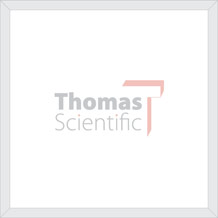Protein, 5 mg
-
Aprotinin from Bovine Lung
MP BiomedicalsAprotinin is a protein consisting of 58 amino acids, arranged in a single polypeptide chain that is crosslinked by three disulfide bridges. Aprotinin is found in bovine lymph nodes, lung, parotid gland, spleen, liver, pancreas, seminal vesicles, thyroid gland, kidney, mucous membranes of the…
-
Lectin, Wheat Germ Agglutinin from Triticum vulgaris
MP BiomedicalsLectins are proteins or glycoproteins of non-immune origin that agglutinate cells and/or precipitate complex carbohydrates. Lectins are capable of binding glycoproteins even in presence of various detergents. The agglutination activity of these highly specific carbohydrate-binding molecules is…
-
Streptavidin
MP BiomedicalsStreptavidin is a protein produced by the bacterium Streptomyces avidinii. It has four binding sites for biotin, as does avidin. Both have been used extensively as probes in immunochemical systems, conjugated to antibodies, enzymes or fluorochromes. However, avidin is highly basic (pI ~ 10.5),…
-
Fibronectin from Bovine Plasma
MP BiomedicalsFibronectin are adhesive glycoproteins and are found both as cell surface proteins and in plasma. They are large glycoproteins found in cells and extracellular fluids. They are involved in a wide range of biological activities including cell adhesion to extracellular matrices, blood coagulation and…
-
Streptavidin
G-BiosciencesRecombinant streptavidin from streptomyces avidinii, produced in E.coli. Biotin, a 244Da vitamin (Vitamin H) molecule, exhibits an extraordinary binding affinity for streptavidin (Ka=10 15 M -1 ). Biotin and streptavidin interaction is rapid and once the bond is established it can survive up…
-
Protein A from Staphylococcus aureus (Cowan Strain)
MP BiomedicalsProtein A is a highly stable surface receptor which is capable of binding the Fc portion of immunoglobulins, especially IgGs, from a large number of species. Each protein A molecule can bind 2 molecules of IgG, allowing the formation of a precipitate. Protein A may be coupled to a wide variety…
-
Angiotensin II Human from Synthetic
MP BiomedicalsAngiotensin II is a peptide hormone which plays an important role in the regulation of blood pressure. It stimulates the release of aldosterone from the adrenal gland. It has strong vasoconstrictive effects. Angiotensin II plays an important role in the regulation of blood pressure. It…
-
sPLA2 (Type III)
Cayman ChemicalEC 3.1.1.4 Active enzyme isolated from bee venom One unit of enzyme hydrolyzes one µmol of Diheptanoyl Thio-PC per minute at 25°C PLA2 catalyzes the hydrolysis of fatty acids at the sn-2 position of glycerophospholipids, yielding a free fatty acid and a lysophospholipid. PLA2…
-
Pokeweed Mitogen, Crude, LY
MP BiomedicalsPokeweed mitogen is extracted from pokeweed roots. This protein has hemagglutinating, leukoagglutinating, and mitogenic properties. PWM is not blood group specific, but has affinity for N-acetyl-β-D-glucosamine oligomers. Reconstitution: Reconstitute with 0.01M sodium phosphate-0.15M sodium…
-
Avidin from Egg White, ~10-15 u/mg Protein
MP BiomedicalsAvidin is a basic glycoprotein consisting of four essentially identical subunits. The combined molecular weight of the subunits is about 66,000. Each subunit is a single polypeptide chain containing 128 amino acid residues with alanine at the N-terminal, glutamic acid at the C-terminal, and a…
-
Protein A from Staphylococcus aureus, Fc Binding Grade
MP BiomedicalsProtein A is a recombinant Fc-binding protein from Staphylococcus aureus, Cowan strain-1 gene. The product is a carboxy truncated material containing 301 amino acid residues. The non-binding regions have been removed to minimize potenial steric interference. Protein A may be conjugated with…
-
Purified Human Serum IgA
MP BiomedicalsThe product is tested for purity at a minimum of 20 mg/mL using immunoelectrophoresis. The product is human serum IgA; no trace of IgG, IgM or non-immunoglobulin serum proteins is detected. The total protein is determined using the Biuret procedure, with bovine albumin as the standard. Each vial is…
-
Avidin from Egg White
MP BiomedicalsAvidin is a basic glycoprotein isolated from raw egg white. It exhibits high binding affinity for biotin and is capable of producing biotin deficiency in rats and chicks. It also occurs in the white portion of eggs and the oviducts of birds and amphibia. It is destroyed by cooking or irradiation. …
-
Melittin
Cayman ChemicalThe principal cytotoxic component of bee venom; assembles as tetramers on membrane surfaces to form pores, resulting in cell death.
















